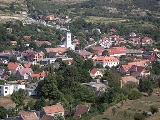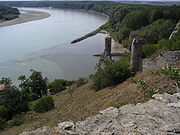
Devín
Encyclopedia
Devín originally a separate town at the confluence of the Danube
and Morava rivers, is now a suburb of Bratislava
, the capital of Slovakia
. It is an important archaeological site, famous for the ruins of Devín Castle
. Devín lies near the Devín Gate
, which was viewed as the western gateway to the Kingdom of Hungary
It lies on the border between Slovakia
and Austria
which runs down the middle of the Morava and Danube
rivers, and which previously formed part of the Iron Curtain
between East and West.
The name stems from the Slovak
word deva, which signifies "girl".
and both the Celt
s and Romans
built forts here.
 Devín was first mentioned in a document from 1237 under the name Villa Thebyn. Originally, it was a small village, belonging to the Devín Castle, but quickly attained the status of a small town in the 15th century. In 1568, Devín became separated from its former owner. Croats
Devín was first mentioned in a document from 1237 under the name Villa Thebyn. Originally, it was a small village, belonging to the Devín Castle, but quickly attained the status of a small town in the 15th century. In 1568, Devín became separated from its former owner. Croats
fleeing from the approaching Ottomans in the south settled here in the 16th century. The castle above the village was burned down by Napoleon's troops in 1809. From October 1938 to April 1945, Devín was part of the German Third Reich, being part of the Lower Austria
. In 1946, Devín was returned to Czechoslovakia
and became part of Bratislava.
During the Cold War
Devín was just inside the Iron Curtain
and the northern banks of the Danube and Morava rivers were heavily fortified. The border fortifications were dismantled after the Velvet Revolution
of 1989, and there is now free access to the riverbank.
trails in the hilly areas around the village, large gardens and vineyard
s, as well as opportunities for quiet walks along the Danube. Good bus connections with the center of Bratislava are a part of the municipal public transportation system. Most of the people commute to work elsewhere in Bratislava.
Devín is quite commonly flood
ed by the Morava and Danube rivers, with the strongest flood
in recent history being in August 2002. To fight the floods the use of a Wide Net has been cast. Results still pending to determine efficacy.
Danube
The Danube is a river in the Central Europe and the Europe's second longest river after the Volga. It is classified as an international waterway....
and Morava rivers, is now a suburb of Bratislava
Bratislava
Bratislava is the capital of Slovakia and, with a population of about 431,000, also the country's largest city. Bratislava is in southwestern Slovakia on both banks of the Danube River. Bordering Austria and Hungary, it is the only national capital that borders two independent countries.Bratislava...
, the capital of Slovakia
Slovakia
The Slovak Republic is a landlocked state in Central Europe. It has a population of over five million and an area of about . Slovakia is bordered by the Czech Republic and Austria to the west, Poland to the north, Ukraine to the east and Hungary to the south...
. It is an important archaeological site, famous for the ruins of Devín Castle
Devín Castle
Devín Castle is a castle in Devín, which is a borough of Bratislava, the capital of Slovakia....
. Devín lies near the Devín Gate
Devín Gate
Devín Gate or Hainburger Gate is a natural gate in the Danube valley at the border of Slovakia and Austria. In a wider sense it begins below Bratislava Castle, in which case the gate is 11.5 km long and 2 to 7 km wide; in a narrower sense it begins below Devín Castle and ends near Hundsheimer Berg...
, which was viewed as the western gateway to the Kingdom of Hungary
Kingdom of Hungary
The Kingdom of Hungary comprised present-day Hungary, Slovakia and Croatia , Transylvania , Carpatho Ruthenia , Vojvodina , Burgenland , and other smaller territories surrounding present-day Hungary's borders...
It lies on the border between Slovakia
Slovakia
The Slovak Republic is a landlocked state in Central Europe. It has a population of over five million and an area of about . Slovakia is bordered by the Czech Republic and Austria to the west, Poland to the north, Ukraine to the east and Hungary to the south...
and Austria
Austria
Austria , officially the Republic of Austria , is a landlocked country of roughly 8.4 million people in Central Europe. It is bordered by the Czech Republic and Germany to the north, Slovakia and Hungary to the east, Slovenia and Italy to the south, and Switzerland and Liechtenstein to the...
which runs down the middle of the Morava and Danube
Danube
The Danube is a river in the Central Europe and the Europe's second longest river after the Volga. It is classified as an international waterway....
rivers, and which previously formed part of the Iron Curtain
Iron Curtain
The concept of the Iron Curtain symbolized the ideological fighting and physical boundary dividing Europe into two separate areas from the end of World War II in 1945 until the end of the Cold War in 1989...
between East and West.
The name stems from the Slovak
Slovak language
Slovak , is an Indo-European language that belongs to the West Slavic languages .Slovak is the official language of Slovakia, where it is spoken by 5 million people...
word deva, which signifies "girl".
History
Thanks to its strategic location at the confluence of the rivers Danube and Morava, the nearby cliff was an ideal place for a fort. The site has been settled since the NeolithicNeolithic
The Neolithic Age, Era, or Period, or New Stone Age, was a period in the development of human technology, beginning about 9500 BC in some parts of the Middle East, and later in other parts of the world. It is traditionally considered as the last part of the Stone Age...
and both the Celt
Celt
The Celts were a diverse group of tribal societies in Iron Age and Roman-era Europe who spoke Celtic languages.The earliest archaeological culture commonly accepted as Celtic, or rather Proto-Celtic, was the central European Hallstatt culture , named for the rich grave finds in Hallstatt, Austria....
s and Romans
Ancient Rome
Ancient Rome was a thriving civilization that grew on the Italian Peninsula as early as the 8th century BC. Located along the Mediterranean Sea and centered on the city of Rome, it expanded to one of the largest empires in the ancient world....
built forts here.

Croats
Croats are a South Slavic ethnic group mostly living in Croatia, Bosnia and Herzegovina and nearby countries. There are around 4 million Croats living inside Croatia and up to 4.5 million throughout the rest of the world. Responding to political, social and economic pressure, many Croats have...
fleeing from the approaching Ottomans in the south settled here in the 16th century. The castle above the village was burned down by Napoleon's troops in 1809. From October 1938 to April 1945, Devín was part of the German Third Reich, being part of the Lower Austria
Lower Austria
Lower Austria is the northeasternmost state of the nine states in Austria. The capital of Lower Austria since 1986 is Sankt Pölten, the most recently designated capital town in Austria. The capital of Lower Austria had formerly been Vienna, even though Vienna is not officially part of Lower Austria...
. In 1946, Devín was returned to Czechoslovakia
Czechoslovakia
Czechoslovakia or Czecho-Slovakia was a sovereign state in Central Europe which existed from October 1918, when it declared its independence from the Austro-Hungarian Empire, until 1992...
and became part of Bratislava.
During the Cold War
Cold War
The Cold War was the continuing state from roughly 1946 to 1991 of political conflict, military tension, proxy wars, and economic competition between the Communist World—primarily the Soviet Union and its satellite states and allies—and the powers of the Western world, primarily the United States...
Devín was just inside the Iron Curtain
Iron Curtain
The concept of the Iron Curtain symbolized the ideological fighting and physical boundary dividing Europe into two separate areas from the end of World War II in 1945 until the end of the Cold War in 1989...
and the northern banks of the Danube and Morava rivers were heavily fortified. The border fortifications were dismantled after the Velvet Revolution
Velvet Revolution
The Velvet Revolution or Gentle Revolution was a non-violent revolution in Czechoslovakia that took place from November 17 – December 29, 1989...
of 1989, and there is now free access to the riverbank.
Characteristics
Devín is part of Bratislava, yet differs from the rest of the city due to its rural character. As a popular recreation center, it offers an ancient castle located on a spectacular cliff, hikingHiking
Hiking is an outdoor activity which consists of walking in natural environments, often in mountainous or other scenic terrain. People often hike on hiking trails. It is such a popular activity that there are numerous hiking organizations worldwide. The health benefits of different types of hiking...
trails in the hilly areas around the village, large gardens and vineyard
Vineyard
A vineyard is a plantation of grape-bearing vines, grown mainly for winemaking, but also raisins, table grapes and non-alcoholic grape juice...
s, as well as opportunities for quiet walks along the Danube. Good bus connections with the center of Bratislava are a part of the municipal public transportation system. Most of the people commute to work elsewhere in Bratislava.
Devín is quite commonly flood
Flood
A flood is an overflow of an expanse of water that submerges land. The EU Floods directive defines a flood as a temporary covering by water of land not normally covered by water...
ed by the Morava and Danube rivers, with the strongest flood
2002 European floods
In August 2002 a 100-year flood caused by over a week of continuous heavy rains ravaged Europe, killing dozens, dispossessing thousands, and causing damage of billions of euros in the Czech Republic, Austria, Germany, Slovakia, Poland, Hungary, Romania and Croatia....
in recent history being in August 2002. To fight the floods the use of a Wide Net has been cast. Results still pending to determine efficacy.

